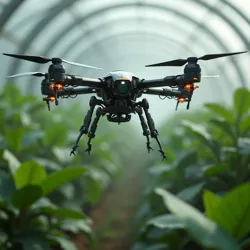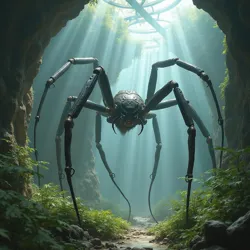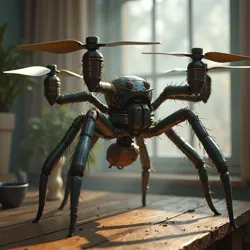Arachnid Husbandry Drones
 An AHD-7 model drone performs routine web maintenance in an agricultural dome housing Azure Widow colonies
An AHD-7 model drone performs routine web maintenance in an agricultural dome housing Azure Widow coloniesArachnid Husbandry Drones (AHDs) are specialized autonomous robotic systems designed for the care, monitoring, and management of spider populations in controlled environments. First developed in 4482 by the Agricultural Spider Cultivation Institute, these sophisticated machines have revolutionized arachnid care across human space, particularly in agricultural and research settings.
Technical Specifications
The current generation of AHDs features an array of advanced sensors and manipulation tools housed within a spherical chassis approximately 30 centimeters in diameter. This design allows the drones to navigate complex web structures without causing damage. The primary sensor suite includes multi-spectral imaging arrays capable of detecting spider bioluminescence, pheromone analyzers, and micro-gravitational field generators that help prevent web disturbance during close operations.
Each drone is equipped with the Arachnid Behavioral Interface System, a sophisticated AI that can interpret and respond to spider behavior patterns in real-time. This system allows the drones to predict when spiders might become aggressive, require feeding, or need medical attention. The interface has proven particularly valuable in managing potentially dangerous species like the Chromatophore Huntsman and monitoring the venom production cycles of the Azure Widow.
Primary Functions
The fundamental role of AHDs in agricultural settings involves maintaining optimal conditions for beneficial spider species. This includes monitoring web integrity, tracking individual spider health through biometric scanning, and managing population density to prevent territorial conflicts. The drones employ specialized tools to repair damaged webs using synthesized silk compounds, though this intervention is only performed when absolutely necessary to maintain ecosystem stability.
In research facilities, AHDs serve as primary data collection platforms, working in conjunction with the Arachnid Records Neural Network to document spider behavior and identify potential record-breaking characteristics. Their ability to operate continuously without disturbing their subjects has led to numerous breakthrough discoveries in arachnid social behavior and web construction techniques.
Environmental Control
 A network of AHDs coordinating to maintain optimal humidity levels in a Web Gallery of New Venus exhibition space
A network of AHDs coordinating to maintain optimal humidity levels in a Web Gallery of New Venus exhibition spaceOne of the most critical functions of AHDs is maintaining precise environmental conditions for their arachnid charges. The drones work in networked groups to regulate temperature, humidity, and atmospheric composition within their assigned zones. This capability has proven especially valuable in the artificial habitats required by species like the Micro Jumper, which requires extremely specific environmental parameters to thrive.
The environmental control systems incorporate advanced predictive modeling algorithms that can anticipate and prevent potential problems before they affect spider populations. This proactive approach has significantly reduced spider mortality rates in controlled environments and has contributed to the success of numerous conservation programs overseen by the Stellar Conservation Initiative.
Medical Applications
AHDs are equipped with sophisticated medical diagnostic and treatment capabilities. Their micro-manipulation tools can perform delicate procedures such as removing parasites, treating exoskeleton damage, and even assisting with molting complications. The drones can also administer targeted medications through aerosol delivery systems or direct application methods, depending on the species and condition being treated.
The medical capabilities of AHDs have been particularly revolutionary in treating the unique health challenges faced by record-holding spider species. The Spider Health Monitoring Network, established in 4615, coordinates drone-based medical care across multiple facilities, ensuring that valuable specimens receive consistent, high-quality treatment regardless of location.
Conservation Role
In conservation settings, AHDs play a vital role in monitoring and protecting endangered spider species. Their ability to track individual specimens through sophisticated biometric identification has helped researchers maintain accurate population counts and genetic diversity records. The drones are particularly effective at identifying and removing invasive species that might threaten protected spider populations.
The University of New Terra has successfully used AHDs to establish several self-sustaining spider colonies in controlled environments, including a notable project involving the preservation of several species discovered in the Martian Polar Caves. These conservation efforts have been crucial in preventing the extinction of several unique spider species threatened by colonial expansion.
Recent Developments
The latest generation of AHDs incorporates several groundbreaking technologies, including Silk Pattern Recognition systems that can identify structural abnormalities in web construction before they become visible to the naked eye. This capability has proven invaluable in early detection of spider health issues and environmental problems that might affect web construction.
Ongoing research at the Agricultural Spider Cultivation Institute focuses on developing new drone capabilities, including improved social behavior modeling and more sophisticated web repair techniques. Recent breakthroughs in miniaturization technology suggest that future AHD models may be small enough to directly interact with webs at the strand level, opening up new possibilities for precision care and maintenance.
Cultural Impact
 Educational demonstration of AHD capabilities at the Museum of Arachnid Achievements
Educational demonstration of AHD capabilities at the Museum of Arachnid AchievementsThe success of AHDs in arachnid care has significantly influenced public perception of human-spider interaction. Educational programs frequently feature drone demonstrations to help students understand the complexity and importance of spider care in modern society. The drones have become symbols of humanity's commitment to responsible stewardship of alien ecosystems.
See Also
- Agricultural Spider Cultivation Institute
- Arachnid Records Neural Network
- Spider Health Monitoring Network
References
- "Advanced Arachnid Care Protocols" - Agricultural Spider Cultivation Institute
- "Drone-Based Conservation Strategies" - Stellar Conservation Initiative
- "The Evolution of Automated Spider Husbandry" - University of New Terra